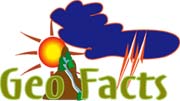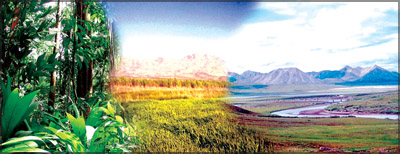The world of biomes
 Have
you ever heard the word 'biome'? Some of you must have. Today, we will
explore the world of biomes so that all of you can be educated about
them. First, let's see what biomes are. Have
you ever heard the word 'biome'? Some of you must have. Today, we will
explore the world of biomes so that all of you can be educated about
them. First, let's see what biomes are.
Biomes are the various regions of our planet that can best be
distinguished (differentiated) by their climate, fauna and flora. There
are different ways of classifying biomes, but the common elements are
climate, habitat, animal and plant adaptation, biodiversity and human
activity.
Biomes are defined as 'the world's major communities, classified
according to the major plant life and
|

Forest biome
Grassland biome
Tundra biome
|
characterised by adaptations of organisms to that particular
environment'. Biomes have moved and changed many times during the
history of life on Earth. More recently, human activities have
drastically altered these communities.
Biomes are grouped into six major types; Desert, Freshwater, Marine,
Forest, Grassland and Tundra. It is important to know the
inter-relationship between each of these elements in a biome. A change
in one affects the other directly or indirectly.
Why organise natural world into
biomes?
Have you ever wondered why these biomes are organised into various
categories? To understand why biomes are classified as they are, we
should first know what characterises a biome.
Biomes (bioclimatic zones) are appropriate divisions to organise the
natural world, because the organisms that live in each of them possess
adaptations which are common to them, in particular to the climate of
each zone and to the characteristic vegetation types that develop in
them.
All the elements of a biome exist in some meaningful relationship
with each other. A change in one (e.g. the habitat) leads to a change in
the biome. The original hunter/gatherer populations had relatively
little effect on the environment, but with the increase in population, a
substantial proportion of large animals have been hunted out.
Habitat destruction has also been caused by small-scale
slash-and-burn agriculture and large-scale land clearing for ranching
and farming.
Exploring different biomes
Different scientists classify biomes in different ways. For example,
biomes have been listed as tundra, coniferous forests, grasslands,
shrublands, rainforests, temperate deciduous forests and deserts.
Conservation and preservation of
biomes
|

Marine biome
Desert biome
Freshwater biome
|
Because of the rapid changes made in the area of technology, biomes
are also prone to change just like any other place on Earth. Let's see
how this happens. Biomes have changed many times during the history of
life on Earth. Different biomes have different effects on the planet.
The world's oceans have an even greater effect on global climate than
forests. More recently, human activities have drastically altered these
communities.
Thus, the conservation and preservation of biomes should be a major
concern for all. We must understand how human activity affects these
biomes. Aquatic biomes are the most valuable and they are also the most
threatened by pollution.
A closer look at a desert biome
We will bring you information about all the different biomes in our
future issues. But, today we will brief you on the desert biome just to
give you a rough idea of what it's like.
Deserts seem to be the most inhospitable biome for humans, but humans
have been able to adapt to desert life for hundreds of years. As long as
traditional lifestyles remained in effect, the human impact on the
desert was not severe. Desert dwellers understood the need to maintain a
balance between themselves and their environment.
With rapid growth in population and firearms, animals were hunted
down. Popular desert plants such as cacti, and animals such as lizards
started to be sold at high prices to collectors. Many of these species
are threatened as a result. Desertification continues at a fast rate.
In our next issues, we will brief you about the other biomes in the
world.
Janani Amarasekara |
